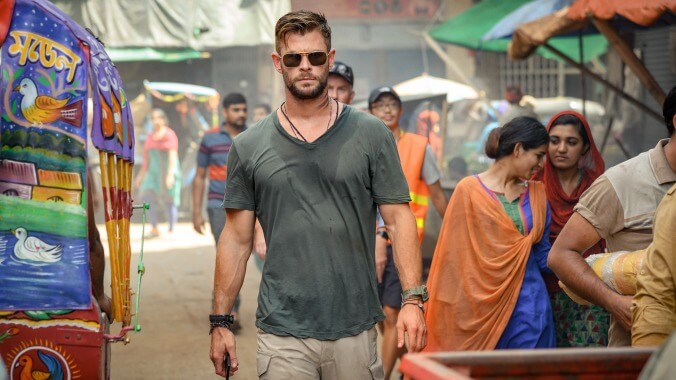Chris Hemsworth reunites with some Marvel talent for the grisly but generic Extraction


Chris Hemsworth’s talent lies mostly in comedy, but his looks and physique have all but ensured a career of glowering he-man roles. Nonetheless, the Marvel veterans behind Extraction really should have known better. The film, which is exactly as generic as its title, casts Hemsworth as Tyler Rake, a name that follows the same classic Schwarzenegger formula that gave us Harry Tasker and John Matrix. He’s an Australian soldier of fortune with a drinking problem, a self-destructive streak, and an attitude—so not so much a vintage Arnie role as yet another attempt to turn Hemsworth into a new and less problematic Mel Gibson. Add a script that would have seemed derivative even in the early ’90s, and you begin to get a sense of the kind of undigested pastiche that director Sam Hargrave and writer-producer Joe Russo are going for.
Russo is of course better known for co-directing various Captain America and Avengers movies with his brother, Anthony, all of which Hargrave worked on—first as a stunt double, then as fight coordinator, and finally as second-unit director. But anyone hoping to see the better qualities of those Marvel mega-blockbusters here will be disappointed. The plot is merely functional. Ovi (Rudhraksh Jaiswal), the teenage son of an imprisoned Indian crime lord, has been kidnapped by his father’s Bangladeshi rival, Amir Asif (Priyanshu Painyuli)—a man so evil that he watches one of his henchmen throw a (different) child off a roof. Tyler is hired by Ovi’s dad to recover the boy. Things go south, and soon the mercenary finds himself fighting through the streets of the Bangladeshi capital, Dhaka, with the kid in tow.
Obviously, action is the main selling point. The movie’s pièce de résistance is an especially ludicrous example of those gimmicky sequences in which different shots are digitally pasted together to look like one long, unedited take. The scene, which runs about 12 minutes, doesn’t exactly vaunt Extraction into the pantheon of single-take action wonders that includes the staircase sequence in The Protector, the hallway fight in Oldboy, and the stakeout-turned-shootout from Breaking News. (None of which, it should be noted, feature hidden edits.) The cut points are both plentiful and glaringly obvious. And while the choreography does a good job of making Hemsworth look like a badass killer, it’s painfully repetitive—a lot of AK fire, defenestration, and knifing.
What actually sets the film apart from other mainstream action movies is the sadistic gnarliness of the violence, which appears heavily inspired by Indonesian action flicks like The Raid, The Raid 2, and The Night Comes For Us. Throats are crushed, necks are snapped, and blood periodically gushes on the lens. The first fight scene in the film, in which an unarmed Tyler dispatches a room full of assailants with whatever’s at hand, is grisly and actually pretty fun. He even kills a man with a rake, though the movie sadly spares us what should be a well-earned one-liner. The real difference between the film and its likely influences is that the Indonesian offerings are martial arts movies at heart, which is to say they involve fights with skilled combatants. Extraction, however, sticks to the American model of body counts.
With the exception of the rival killer, Saju (Randeep Hooda), Tyler’s assailants constitute an endless army of undifferentiated foot soldiers. Later come the inevitable helicopters and rocket launchers. As a Netflix release, the film is literally a glorified direct-to-video action movie—albeit one that lacks the momentum and efficiency that defines the best entries in the DTV category. As a director, Hargrave shows more proficiency than personality in the action set pieces, though they are still preferable to the dialogue scenes, which simply drag out the unwaveringly predictable plotting and its inevitable turn toward sentimental matters.
In this artless moral universe, the characters, who are about as thin as can be, are grouped into those who are willing to kill children (which includes Amir Asif, most of Tyler’s friends, and even Ovi’s dad) and those who aren’t. For much of the running time, that’s basically just Tyler, though he is given ample opportunity to do so as the film puts one machete-wielding street kid after another in his path while characters keep reminding him that he could toss Ovi to the wolves and go home. We are led to believe that this aversion to violence against the very young is due to reasons of sub-pop-psychological backstory—and not, say, because killing kids is considered distasteful even by the standards of hyper-violent action movies. Frankly, it would be more interesting if he did just spend the movie wasting minors left and right. But that’s a level of Peckinpah-ian nihilism that absolutely no one involved in this production seems either equipped or willing to broach.